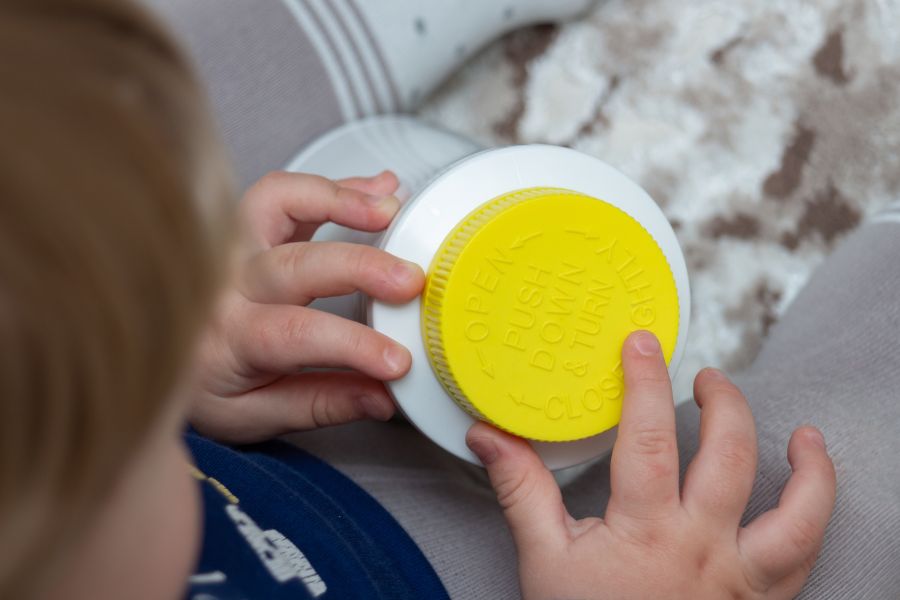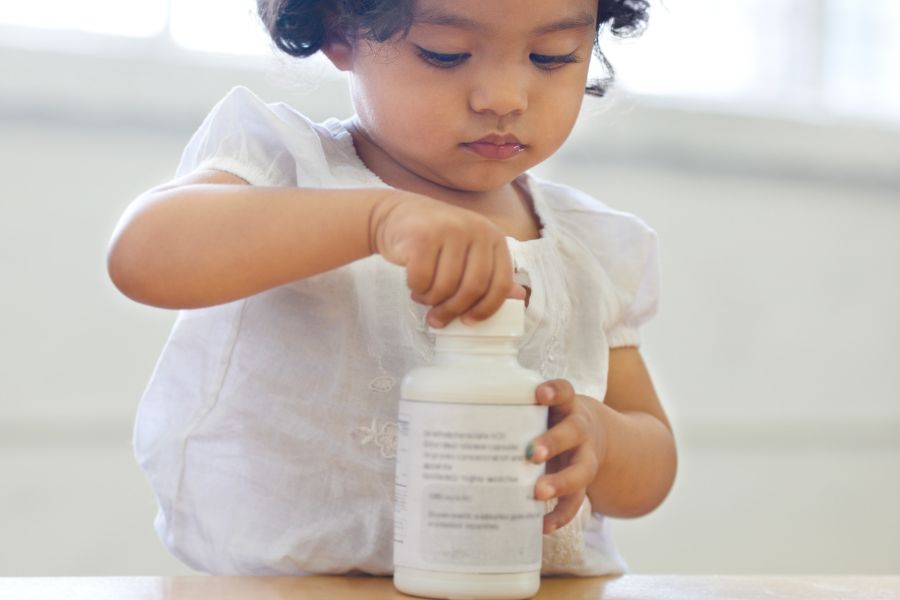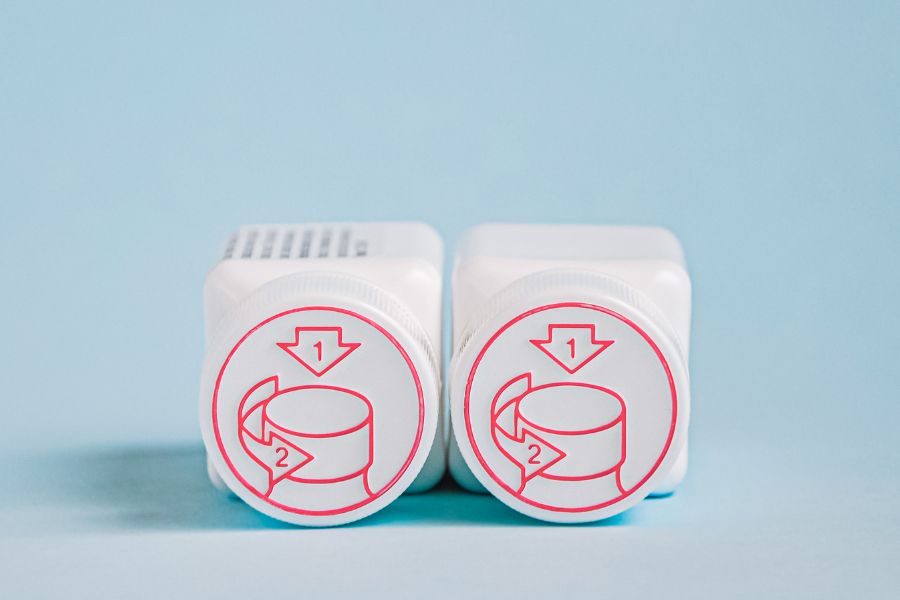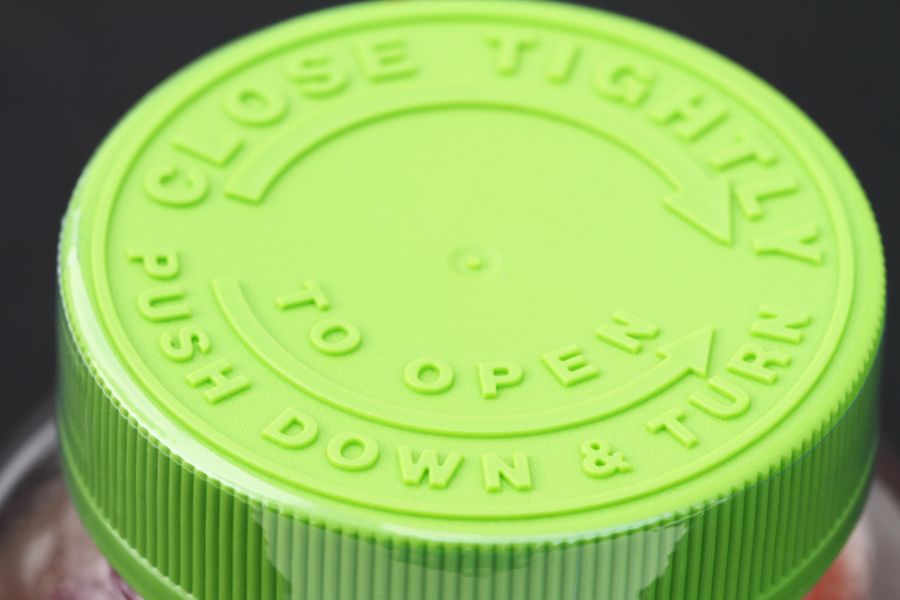Guide to Child Resistant Caps & Closures

Child resistant (CR) caps and closures have been a fixture in the market for quite some time, yet their significance may often go unnoticed by the average consumer. In reality, these safety features play a crucial role in safeguarding children from potentially life-threatening products. In this article, we’ll delve into the concept of child resistance, explore the mechanics behind these caps, distinguish them from tamper-evident seals, and shed light on the various industries that rely on child-resistant caps and closures.
What is child resistant packaging?
A child resistant closure (CRC) serves a clear purpose: it’s designed to make a package difficult for a child to open. Specifically, a child resistant container is intended to be challenging for children under 5 years old to open, while remaining manageable for adults with full use of their hands.
It’s important to note that child-resistant closures aren’t “child-proof” in the sense that they are completely impenetrable to children. Instead, the standard is based on how long it takes a child to open the container, not whether they can open it at all.
You’ve probably come across child resistant caps and closures on bottles or jars containing pharmaceutical drugs and other medicinal products. A common design feature of these caps requires you to push down while turning them to open, making the process more challenging for young children. This design prevents children from accidentally accessing containers with potentially harmful substances.
Imagine the same pill bottle with a cap that easily flips open; this would pose a significant risk as children could accidentally open and ingest the pills, which could be fatal.
CRC closures, despite their intended safety benefits, unintentionally pose accessibility challenges for individuals with disabilities. Despite significant strides in disability awareness and advocacy, there are still factors to take into account, and products tailored to address these concerns which have yet to reach the market.
Notably, the requirement for these caps is mandated by the Poison Prevention Packaging Act (PPPA), which aims to protect children from exposure to poisonous and hazardous materials. The oversight of these caps falls under the jurisdiction of the United States Consumer Product Safety Commission (CPSC) and the Environmental Protection Agency (EPA). Both of these agencies are federally supported, making child resistant caps a legal requirement in all 50 states.

Why is child resistant packaging important?
Child resistant packaging is essential for a few reasons. First, it helps to protect young children from accidental exposure to harmful substances. These specially designed closures and containers require a combination of manual dexterity and strength making it difficult for young children to open, which reduces the risk of poisoning and injury.
Second, child resistant packaging is a legal requirement in many jurisdictions. Manufacturers must comply with these regulations to protect consumers and avoid legal consequences. Child resistant packaging helps ensure that products reach consumers with the necessary safety measures in place, reinforcing its critical role in modern consumer protection.
The importance of CRC packaging should be a top priority when producing potential hazardous products. While child-resistant is not the same as childproof, CRC closures are a beneficial safety measure aimed at deterring small children from accessing the products within.
How does child resistant packaging work?
One of the most common child resistant caps is the push-down and turn. This child resistant cap design can be identified with instructions to ‘push-down and turn’ or a pictorial image of the push-down and turn motion molded onto the plastic cap. This design consists of two pieces, an over cap and an inner cap. Both pieces have toothed edges that correspond with each other — similar to two gears that aren’t engaged.
When simply twisting the cap without any pressure, these two gears will spin without touching each other. Since the teeth of both pieces do not have pressure to lock together, the cap will continue to spin without releasing from the container.
Once downward pressure is applied which pushes the plastic pieces together, the gears will engage. Once this motion is accompanied by spinning, the engaged gears will spin together. The inner piece of the cap typically has a thread that matches the thread on the container at the rim (where the cap is).
Now that the two-piece mechanism is engaging and spinning, the threads will spin and remove the cap from the container.
There are additional child resistant cap designs, but all designs involve applying pressure on a specific part of the cap to release it from the container.
Are child resistant caps also tamper-evident?
Tamper evident and child resistant are not the same thing when talking about caps and closures. Tamper-evident caps and seals are designed to show signs of tampering, such as a broken seal or a missing tamper band, if they have been opened. Child resistant caps, on the other hand, are designed to be difficult for children to open, but easily accessible to most adults.
Tamper-evident components are used to protect products from being tampered with, but once opened, the seal or wrap is broken making the product easily accessible if not accompanied by a child resistant closure. Child resistant caps are used to prevent children from accidentally ingesting harmful substances. Products that contain hazardous materials, such as pharmaceuticals or household products are usually required to utilize both child resistant closures and a tamper-evident seal or liner.
Both tamper-evident and child resistant caps are important safety features. However, they are designed for different purposes. Tamper-evident caps protect products from being tampered with, while child resistant caps protect children from accidentally ingesting harmful substances.

Are child resistant caps required for specific products?
Today, ensuring the safety of consumers is a top priority. Child resistant caps have become a crucial component in safeguarding children from potentially harmful household and pharmaceutical products. CRC closures are required for specific types of consumer products due to their ability to prevent access to children under five years of age without assistance. Next, we’ll dive into some of the products and applications that require CRC closures.
Medications
Medications, such as prescription drugs and over-the-counter medicines often contain substances that can be harmful or even fatal if ingested inappropriately, especially by children. Child-resistant closures on medication packaging are essential to prevent accidental ingestion, promoting the safety and peace of mind of households and minimizing the risk of poisoning incidents.
Poisons and Pesticides
Poisons and pesticides are inherently toxic substances that can pose severe health risks if mishandled or ingested. Child-resistant closures are crucial in this context to prevent accidental exposure and ingestion by children who may be curious about such products. These closures act as a protective barrier, reducing the likelihood of forced access by such children.
E-cigarettes and Vaping Products
E-cigarettes and vaping products typically contain nicotine, which is a highly addictive and potentially harmful substance. Child-resistant closures on these products help reduce the risk of children gaining access to the devices or e-liquids and deter accidental nicotine poisoning when closed properly.
Cannabis Products
Cannabis products, whether for medical or recreational use, often come in a variety of products, including edibles and tinctures. Child-resistant closures are mandated to prevent children from accidentally consuming these products, helping to ensure that cannabis remains inaccessible to those who are not of legal age.
Cleaning Products
Cleaning products often contain chemicals that can cause harm if ingested or if they come into contact with the skin. Utilizing child-resistant closures on these potentially harmful products is essential to safeguard households, particularly where small children may be present, minimizing the risk of accidental exposure to toxic substances.
Lighters and Matches
Lighters and matches are fire-starting devices that can pose serious risks if used improperly. Child-resistant closures on these products are designed to prevent young children from igniting them accidentally, reducing the risk of fire-related incidents and promoting overall safety.
Household and Automotive Chemicals
Various household and automotive chemicals, such as solvents and lubricants, can be hazardous if not handled properly. Child-resistant closures on the packaging help prevent unintentional access, reducing the risk of accidental spills, inhalation, or ingestion by young children.
Certain Cosmetic and Personal Care Products
There are certain types of cosmetics and personal care products that may contain substances that can be harmful if ingested or misused. Utilizing safety components such as child-resistant closures and special packaging can help reduce the risk of accidental exposure, ingestion, or mishandling by young children.
Insecticides
Insecticides are often formulated with powerful chemicals aimed at exterminating pests. Using child-resistant closures on insecticide products is crucial to protect against accidental exposure or ingestion by young children. Utilizing CRC closures helps to ensure that these potentially harmful substances are securely stored, out of reach, and their applications are tightly controlled.

What are common challenges with child resistant closures?
It’s important to reiterate that child-resistant closures should not be confused with childproof packaging, however using child-resistant closures in certain types of packaging can mean the difference between life and death. While we’ve addressed the advantages of CRC closures, now let’s take a look at some of the common challenges faced with child-resistant closures.
Accessibility for Adults
Ensuring that child-resistant closures remain accessible to adults while presenting a challenge to young children is a delicate balance. Striking this balance requires designing closures that can be opened without too much effort by adults but pose a significant obstacle for children under five years of age.
User Confusion
The risk of user confusion arises when the design of child-resistant closures is overly complex or lacks clear instructions. There are some cases where adults may struggle to open a child-resistant closure if it is too complicated to figure out. Striving for simplicity and clarity in design is essential to minimize the potential for confusion among consumers, especially those dealing with child-resistant closures for the first time.
Product Compatibility
Developing child-resistant closures that are compatible with various product types and packaging materials poses another common challenge. Achieving versatility in design to accommodate different products while maintaining effectiveness is a key consideration during the manufacturing process.
Regulatory Changes
Keeping up with evolving regulations regarding child-resistant closures is crucial. Manufacturers must navigate changes in standards and compliance requirements in order to ensure their products meet the latest regulatory expectations.
Tampering Resistance
While the function of child-resistant closures is to deter young children from accessing the product, incorporating additional protective measures such as tamper-evident seals or liners adds another layer of consumer safety.
Sustainability
Another challenge manufacturers face when offering child-resistant closures is sustainability. While options are limited when it comes to CRC closures, the demand for sustainable and recyclable products continues to rise. Utilizing materials such as PCR plastics is a good option.
Testing Variability
Ensuring consistent and reliable testing procedures for child-resistant closures is another challenge manufacturers must face. Variability in everything from testing protocols to packaging variations can impact the reliability of closures. For example, if you order the same size bottle from the same manufacturer but have to switch due to availability, a slight variation in neck finish could affect the fit of your closures deeming them unreliable. Therefore thorough testing should always be conducted when switching product suppliers.

Regulations and Standards for Child-Resistant Packaging
Regulations and standards for child-resistant packaging are critical in ensuring the safety of children and preventing accidental access to potentially harmful substances. These guidelines set forth specific requirements and testing protocols, compelling manufacturers to implement effective child-resistant designs. Compliance with such regulations not only safeguards children from accidental ingestion or exposure but also boosts consumer trust by demonstrating a commitment to product safety and responsible packaging practices.
FDA Regulations
The Food and Drug Administration (FDA) sets specific regulations for child-resistant packaging, especially for pharmaceutical and over-the-counter medications. Compliance with these regulations is critical for ensuring the safety of consumers, particularly children.
ISO 8317 Compliance
ISO 8317 is the international standard that outlines the performance requirements and testing procedures for reclosable packages designated as child-resistant. Adhering to these standards ensures a global approach to child safety and regulatory compliance.
ASTM D3475
ASTM International (ASTM), previously known as the American Society for Testing and Materials, is an international standards organization with over 12,000 ASTM standards currently operating globally.
ASTM D3475 comprises the standard classification for child-resistant packaging. The ASTM standard provides examples of child-resistant packaging to improve comprehension and facilitate understanding for each classification type. Manufacturers must follow these protocols to assess the effectiveness of their closures and ensure they meet industry standards.
Testing Protocols
Establishing rigorous testing protocols is essential to evaluate the functionality of child-resistant closures. Thorough and standardized testing procedures contribute to the reliability and effectiveness of these safety features.
Certification Marks
Products meeting specific child-resistant packaging standards receive certification marks. These marks serve as indicators to consumers and regulatory bodies that the packaging complies with established safety requirements.
Regulatory Changes
Staying attentive to regulatory changes is crucial. Manufacturers must consistently update and adapt their practices to ensure compliance with evolving regulations and stay up to date with the latest industry standards.
Legal Consequences
The Poison Packaging Prevention Act (PPPA), enacted in 1970, serves as an essential safeguard against accidental child poisonings nationwide. It is vital for the success of every business that manufactures and distributes packaging for the beauty, household chemical, and pharmaceutical industries to understand and adhere to this act. The PPPA (16 CFR 1700) mandates potentially toxic household items to be packaged in child-resistant packaging (CRP). The responsibility for enforcing these stringent standards lies with the Environmental Protection Agency (EPA) and the US Consumer Product Safety Commission (CPSC).
As stated by the law and the CSPS, compliant packaging “is designed or constructed to be significantly difficult for children under 5 years of age to open or obtain a toxic or harmful amount of the substance contained therein within a reasonable time and not difficult for most adults to use properly, but does not mean packaging which all such children cannot open or obtain a toxic or harmful amount within a reasonable time.” For a company’s product to be child-resistant, a third-party establishment must test the packaging according to federal requirements.
The CPSP is committed to its responsibility of enforcing the PPPA. Failing to comply with child-resistant packaging standards and regulations is treated as a misbranding violation under the Federal Food, Drug, and Cosmetic Act (FDC). Companies that violate this law, whether knowingly or unknowingly, face severe penalties such as fines and even imprisonment, even if the violation did not result in an injury.
Safeguard your company against potential catastrophe by partnering with a child-resistant packaging testing company to ensure your products meet US and international standards.
Design Considerations
Child-resistant packaging design ought to consider various factors, including the type of product, user demographics, and regulatory requirements. A thoughtful and user-friendly design is necessary for balancing safety and usability.

Types of Child-Resistant Closures Available
Child resistant closures come in a variety of designs, each carefully crafted to meet the need of protecting young children from potentially hazardous materials. As the demand for secure packaging grows across industries, manufacturers have developed a variety of mechanisms to achieve child-resistant functionality. From sophisticated push-and-turn closures to dual-function designs, the landscape of child-resistant closures is ever-changing. Here are some of the most common CRC closure styles and applications, but keep in mind that within each style there are various features to consider, such as ribbing, color, neck size and neck finishes.
Push-and-Turn Closures
The push-and-turn closure requires users to push down and simultaneously turn the cap to open. It is a widely used mechanism for its effectiveness in preventing accidental access by young children, and one of the most common styles on the market.
These push-turn closures work with plastic or glass containers and are often used in conjunction with a tamper-evident seal. Push-turn dome caps with droppers for liquid products are also a common item. These closures are commonly used for pharmaceutical & nutraceutical, beauty, and personal care products.
Other CRC Closures
Squeeze-and-Turn Closures
Squeeze-and-turn closures are a variation of the push-turn cap and involve squeezing both sides of the cap while simultaneously turning it. This action creates space between pegs inside the cap and on the outside of the bottleneck. Once enough pressure is applied, the user should be able to twist open the cap. These squeeze-and-turn closures work are commonly found on plastic bottles for pharmaceutical and household chemical products.
Dual-Function Closures
Dual-function closures combine both the push-down and squeeze actions to open the container. This complexity adds an extra layer of protection against unintentional access by small children. These closures are commonly used for pharmaceutical, nutraceutical, beauty, and personal care products.
Snap Closures
Snap closures have a ridge that fits into a groove in the container’s neck. The user lines up the tab on the lid with an arrow on the container. The user can then push up on the tab to open the lid. The lid won’t open if the tab and the arrow aren’t aligned. This type of closure works with plastic bottles and is also commonly used for pharmaceutical, nutraceutical, beauty, and personal care products.

Testing the Effectiveness of Your Child-Resistant Closures
Child resistant closure requirements are commonly misunderstood. Some people think these containers need to be impossible for a child to open. By definition, the cap needs to be unopenable 85% of the time when a child under 5 tries opening it for 5 minutes. In addition, the same scenario needs an 80% success rate between 5 and 10 minutes.
If 8 out of 10 children can’t open the container in 10 minutes, it is considered child resistant.
How are these percentages calculated? Through trials with young children. The CPSC requires testing with children between 42 and 51 months of age (about 3-4 years old) where they are tasked with opening the container.
An observer will note if the child is successful with releasing the cap from the container, and how long it took them. Data from thousands of these tests were compiled to identify the percentage used to define the standard today.
The same experiment is performed with able-bodied adults. An adult should be able to open the container within 5 minutes the first time, and 1 minute the second time. If 90% of adults can pass this test, then the cap is deemed “usable” and appropriate. By meeting these requirements, the cap can go to market and be used on containers in the United States.
If the cap fails either of these tests, it is illegal for the product to be sold or used with the failed cap.
The Future of Child-Resistant Closures
The future of child-resistant packaging is bright. Packaging technology and innovation will continue to enhance safety and usability. Sustainable materials and eco-friendly designs will become even more prevalent, aligning child-resistant packaging with broader environmental goals. As regulatory standards continue to evolve, manufacturers will leverage cutting-edge materials and design principles to meet and exceed these requirements. Ongoing research and development may lead to the creation of more intuitive and user-friendly child-resistant closures, striking a delicate balance between safety and convenience. The future of child-resistant packaging is dynamic, adaptive, and continually evolving to meet the demands of product safety and consumer expectations.
Choose the Best Child-Resistant Closure for Your Product Today!
Choosing the right child-resistant closure for your products is essential to ensuring the safety of households and protecting young children from potential harm. A thoughtful choice in child-resistant caps and closures not only reduces the risk of accidental access but also builds consumer trust by demonstrating a commitment to responsible packaging practices.
Paramount Global is here to help you find the CRC options that best meet your product’s needs. Our packaging specialists can provide guidance on ensuring packaging meets standards to keep children safe from products that may potentially harm them.
Contact us today to speak with a packaging specialist and learn more about how our products or services can help you!
Hayley is a marketing professional and copywriter with a background in crafting content for a diverse range of industries. She has been writing about packaging and supply chain logistics for Paramount Global since 2022. She specializes in explaining complex topics in a clear and engaging way and is an advocate for sustainability in packaging and supply chain management.
Read More
For over forty years, Paramount has been delivering perfectly integrated packaging and supply chain solutions.
